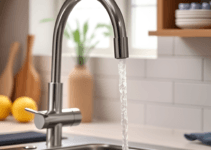Discover the importance of regular carpet cleaning for a healthy home environment. Learn how to effectively maintain your carpets using budget-friendly homemade solutions such as baking soda, vinegar, dish soap, and essential oils. This comprehensive guide covers everything you need to know to keep your carpets clean and fresh while promoting a safer indoor atmosphere. Enhance your living space and prolong the life of your flooring investment with these practical tips and eco-friendly methods for carpet care.
Introduction to Carpet Cleaning
Regular carpet cleaning plays a vital role in maintaining a healthy home environment. Carpets are known to trap an assortment of dirt, dust, allergens, and odors, creating an ideal breeding ground for harmful bacteria and germs. These contaminants can negatively affect indoor air quality, potentially leading to various health issues such as allergies, respiratory problems, and other sensitivities. Therefore, prioritizing carpet care is essential for ensuring both the longevity of the flooring and the health of its inhabitants.

Please, read our post and do not forget to check the YouTube channel “Clean That Up”:
https://www.youtube.com/@CleanThatUp
You will find there, thousands of ideas for your home interior and outdoors.
Allow me to mention one of them:
5 Tips To Clean Your Carpet Like A Pro (video)
In homes where pets reside or young children frequently play on the floor, the need for regular carpet cleaning becomes even more pronounced. Not only do carpets accumulate visible dirt but they also harbor microscopic particles that can provoke allergies and respiratory issues. Additionally, unpleasant odors trapped within the fibers can lead to discomfort for household members and guests alike. Regular cleaning helps to mitigate these issues, fostering a safer and more pleasant living environment.
Cost-effectiveness is another significant consideration when it comes to carpet cleaning. While professional cleaning services can be effective, they often come at a premium, making them less accessible for regular upkeep. In contrast, DIY carpet cleaning solutions offer a budget-friendly alternative, empowering homeowners to maintain their carpets without a hefty financial burden. By employing simple, homemade cleaning mixtures or utilizing affordable commercial products, individuals can effectively remove stains, eliminate odors, and ensure their carpets are as clean and fresh as possible.
In summary, maintaining clean carpets is pivotal not only for aesthetics but also for health and well-being. Adopting a regular carpet cleaning routine, combined with low-cost DIY solutions, serves to enhance the living conditions within the home while ensuring the longevity of one’s flooring investment.
Why Use Homemade Cleaning Solutions?
Homemade carpet cleaning solutions offer several advantages that can make them preferable to commercial products. One of the primary benefits is cost savings. Store-bought carpet cleaners often contain expensive branding and packaging, which can inflate prices. In contrast, creating your own cleaning solutions typically involves using common household items, such as vinegar, baking soda, and dish soap, making it a budget-friendly alternative.
Another significant advantage is the ability to control the ingredients used in your cleaning solutions. Many people are increasingly concerned about the chemicals present in commercial cleaners, which can include harsh substances that may irritate the skin or respiratory system. By utilizing homemade solutions, individuals can ensure they are using safe, non-toxic ingredients, which is particularly important for homes with children or pets. This control over ingredients also extends to adjusting formulations based on specific carpet types or stains, allowing for tailored solutions to meet particular cleaning needs.
Furthermore, using homemade carpet cleaning solutions can reduce chemical exposure in the household environment. Many commercial products are laden with synthetic fragrances and other additives that can contribute to indoor air pollution. By opting for natural alternatives, individuals can create a healthier living space that minimizes the risk of allergies or respiratory issues linked to these chemicals.
Lastly, homemade solutions generally have a lower environmental impact. The ingredients commonly used for DIY cleaning, such as vinegar and baking soda, are biodegradable and do not contribute to harmful waste. This stands in stark contrast to many store-bought solutions, which often come in plastic bottles and contain non-biodegradable chemicals. By making the switch to homemade carpet cleaning, individuals not only save money but also promote a more sustainable and eco-friendly approach to home maintenance.
Baking Soda: A Natural Deodorizer
Baking soda, or sodium bicarbonate, is a versatile and inexpensive compound commonly found in households. Its ability to neutralize odors makes it an excellent choice for carpet cleaning. Unlike many commercial cleaners that can be harsh on both the environment and your carpets, baking soda offers a natural alternative to refresh and deodorize your carpets effectively.
To use baking soda as a carpet cleaner, follow these simple steps. Begin by ensuring your carpet is dry and free of any large debris. Next, take a box of baking soda and evenly sprinkle a generous amount over the area you wish to clean. For larger stains or entire rooms, the more baking soda used, the better the results. After sprinkling, allow the baking soda to sit undisturbed for at least 15 minutes, though leaving it for several hours or overnight can enhance its deodorizing effects.
During this waiting period, baking soda will absorb odors and moisture from the carpet fibers, tackling both light stains and lingering smells. If you are dealing with stubborn stains, consider mixing baking soda with a small amount of vinegar before applying it to the stain. The reaction between these two substances can help lift the stain from the fibers. However, be cautious to test this mixture on a small, inconspicuous area of the carpet before widespread application, as some carpets may react differently to the combination of these substances.
Once the baking soda has had sufficient time to work, it is time to vacuum. Use a vacuum cleaner to thoroughly remove the baking soda from the carpet, ensuring that all of the particles are extracted. This step will not only eliminate the stubborn odors but can also help lift light stains, leaving your carpet looking and smelling fresh. Baking soda serves as an effective, low-cost solution to maintaining clean carpets without the need for expensive cleaning products.
Vinegar: The All-Purpose Cleaner
White vinegar is widely regarded as a versatile and effective cleaning agent, particularly for carpets. Its acidity allows it to break down dirt, grease, and stains, making it an excellent choice for maintaining cleanliness and eliminating odors. To create a vinegar cleaning solution for carpets, a common ratio is one part white vinegar to two parts water. This solution can be mixed in a spray bottle for convenient application.
When using the vinegar solution, apply it directly to the stained area or the entire carpet surface for general cleaning. It is advisable to perform a spot test on an inconspicuous area of the carpet first. This ensures that the vinegar will not adversely affect the carpet’s color or material. After applying the solution, gently blot the area with a clean cloth, allowing the vinegar to penetrate and lift the stain. Following this, rinse the area with cold water and blot dry for optimal results.
One of the significant benefits of using vinegar is its effectiveness against various types of stains and odors. For instance, it can neutralize pet odors and remove stains caused by food or beverages. In addition to its stain-fighting properties, vinegar is also an environmentally friendly option, as it contains no harsh chemicals. However, caution should be exercised when using vinegar on delicate carpets, such as silk or wool, since the acidity may damage these fibers. Always consult the care instructions or seek professional advice if uncertain about the carpet’s material.
In the realm of carpet cleaning, white vinegar stands out as a highly effective, cheap, and easy solution that can tackle numerous challenges, from stubborn stains to lingering odors. Its availability and ease of use make it a popular choice among homeowners looking to maintain their carpets’ appearance and freshness.
Dish Soap: Tackling Greasy Stains
When it comes to effective yet economical carpet cleaning solutions, dish soap stands out as a remarkable option for addressing greasy stains. Dish soap is readily available in most households and, when used correctly, it can efficiently break down and remove grease from carpets. For an effective cleaning solution, a simple recipe combining dish soap and water can be employed.
To create this cleaning solution, mix one tablespoon of liquid dish soap with two cups of lukewarm water. Stir the mixture gently until the soap is well incorporated, avoiding excessive foam. Before applying the solution to the stained area, it is advisable to test a small, inconspicuous section of the carpet to ensure colorfastness and prevent damage. Once the test is confirmed safe, you can proceed to address the greasy stain.
Using a clean, white cloth or sponge, dip it into the dish soap solution and gently blot the stained area. It is important to refrain from rubbing the carpet, as this may worsen the stain or distort the carpet fibers. Instead, focus on blotting the area, applying the solution as needed until the grease begins to lift. Continue this process until you no longer see any transfer of grease to the cloth.
Following the blotting procedure, it is crucial to thoroughly rinse the carpet to eliminate any soap residue, which can attract dirt over time. To do this, use a second clean cloth dampened with plain water to blot the area again, ensuring that all soapy remnants are removed. Finally, allow the carpet to air dry completely, and consider placing a fan nearby to expedite the drying process. Utilizing dish soap as a carpet cleaner is not only cost-effective but also an efficient way to tackle a variety of greasy stains with minimal hassle.
Club Soda: Effective for Wine Stains
Carpet stains, particularly from red wine, can be troublesome and often require immediate attention. One affordable and accessible solution is club soda, which is renowned for its ability to tackle these pesky stains without damaging the carpet fibers. The carbonation in club soda plays a vital role in lifting stains effectively, making it a popular choice for home cleaning.
To remove a wine stain using club soda, first, blot the affected area with a clean, dry cloth or paper towel to absorb any excess liquid. It is important to avoid rubbing the stain, as this can drive it deeper into the carpet fibers. Once you have blotted the area, pour a moderate amount of club soda directly onto the stain. The effervescence of the soda helps to dislodge the wine particles, allowing them to be lifted away from the fibers. After applying the soda, continue to blot the stain with a clean cloth, working from the outer edges toward the center to prevent spreading.
The science behind club soda’s effectiveness lies in its carbonation and salt content. The bubbles help to encapsulate the stain particles and loosen them from the carpet. Meanwhile, the salt acts as a gentle abrasive, further aiding in stain removal without harsh chemicals. It is also important to note that the quicker you act, the better the results. If dealt with promptly, club soda can usually eliminate wine stains before they become permanent.
To maximize the efficacy of this method, ensure that the club soda used is unflavored and unsweetened, as added sugars or flavors can contribute to residue that may attract dirt and cause further stains. By utilizing club soda and following the correct application techniques, individuals can maintain the appearance of their carpets while effectively addressing unsightly stains.
Hydrogen Peroxide: For Tough Stains
Hydrogen peroxide is a versatile and powerful cleaning agent often utilized for tackling tough stains on carpets. Its effectiveness stems from its ability to break down various organic compounds, making it particularly effective against stains such as blood, pet urine, and food spills. When using hydrogen peroxide for carpet cleaning, it is essential to handle it with care due to its bleaching properties, which can potentially alter the color of certain fabrics.
To create a hydrogen peroxide-based cleaning solution, combine one part of 3% hydrogen peroxide with two parts water. This mixture creates an effective stain remover that can be applied directly to the affected area. Before applying this solution, it is advisable to conduct a patch test on a small, inconspicuous area of the carpet to ensure that it does not cause discoloration. Once confirmed to be safe, apply the solution generously, using a clean cloth or sponge to blot the stain.
In addition to its stain-removing properties, hydrogen peroxide can also help eliminate odors associated with pet urine. After applying the solution, allow it to sit for about 5 to 10 minutes to penetrate the fibers before blotting the area with a dry cloth. For particularly stubborn stains, repeating the process may yield better results.
While hydrogen peroxide is generally safe for use on most carpets, it is critical to remember that it can bleach certain dyes. Always ensure the carpet is appropriately rinsed and patted dry after cleaning to remove any residue that could attract dirt. By using hydrogen peroxide effectively, you can maintain your carpets and restore them to their original condition even after tough stains have occurred.
Essential Oils: Scented Freshness
Incorporating essential oils into your carpet cleaning solutions offers not only delightful scents but also beneficial antibacterial properties. Essential oils are natural extracts derived from plants, and their unique characteristics can enhance your cleaning routine. These aromatic oils, such as tea tree, lavender, and eucalyptus, are known for their ability to combat bacteria and mold, making them an excellent addition to homemade carpet cleaning solutions.
To effectively utilize essential oils in your carpet cleaning regimen, consider adding a few drops to your existing cleaning mixtures. For example, when preparing a vinegar-based carpet cleaner, mix equal parts water and white vinegar, then include approximately 10-15 drops of your chosen essential oil. Tea tree oil, with its powerful antimicrobial properties, is particularly effective against dust mites and allergens. Meanwhile, lavender oil not only provides a soothing aroma but is also known for its antibacterial effects.
When selecting essential oils, it is essential to consider your desired fragrance and potential health benefits. Citrus oils, such as lemon or orange, can uplift the atmosphere while combating stale odors. Eucalyptus oil can be particularly refreshing, offering both purification for the carpets and a pleasant scent throughout the home. Additionally, these oils can be used in combination; for example, blending lavender and rosemary can produce both an invigorating and calming effect in your living space.
To maximize the effectiveness of essential oils, ensure proper ventilation while cleaning and allow carpets to dry thoroughly. Using essential oils not only transforms your carpet cleaning process into a more aromatic experience but also promotes a healthier indoor environment. This incorporation of scented freshness can bring new life to your carpets while addressing common cleanliness concerns.
Cornstarch: Reviving Carpet Fibers
Cornstarch is a versatile and cost-effective solution that can breathe new life into your carpets. Often overlooked, this common pantry item serves as an excellent dry cleaner, effectively revitalizing carpet fibers while also helping to absorb odors. It provides a simple yet effective method to refresh carpets without the use of harsh chemicals, making it an attractive option for eco-conscious consumers.
To utilize cornstarch for carpet cleaning, begin by sprinkling a generous amount evenly across the affected area. It is advisable to ensure that the cornstarch covers the spots or stains that require attention. Allow the cornstarch to sit for at least 30 minutes, or longer if possible, as this will enable it to penetrate the fibers and absorb dirt and odors. After this period, vacuum the area thoroughly, ensuring that any trapped grime is lifted along with the cornstarch.
The benefits of using cornstarch extend beyond its cleaning properties. This natural alternative is particularly beneficial for individuals with allergies or sensitivities to synthetic cleaning agents, as it contains no harmful chemicals. Furthermore, it is an economical choice; a small amount of cornstarch can perform effectively, providing substantial savings over traditional carpet cleaning products.
In addition to its effectiveness in rejuvenating carpets, cornstarch can also be used in conjunction with essential oils to eliminate unpleasant smells. Incorporating a few drops of oils such as lavender or tea tree during the application process not only enhances the cleaning performance but also leaves a refreshing scent in the room. This dual action makes cornstarch a practical choice for maintaining the appearance and freshness of carpets between more intensive cleanings.
Other related posts from our website:
https://howtobuildahouseblog.com/choosing-the-perfect-carpet-for-your-childs-room/
Thank you so much for your attention.
Stay tuned. We will upload many other amazing posts to our website and videos onto our YouTube channel.
Thank you so much.
for your time and attention.
Best Regards
See you to another post,
Bye, Bye


